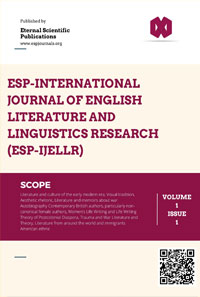ESP International Journal of English Literature and Linguistics Research (ESP-IJELLR)
Citation :
Dharani K, Shobana R, 2025. "The Impact of AI-Driven Language Models on Second Language Acquisition" ESP-International Journal of English Literature and Linguistics Research (ESP- IJELLR) Volume 3, Issue 1: 10-18.
Abstract :
SLA has been revolutionized because of the rapid emergence of AI, and in particular large language models (LLMs) such as Bard, and Claude. Unlike other computer assisted language learning (CALL) applications, these artificially intelligent apps provide personalized and dynamic interactive language learning experiences. This research explores the pedagogical potential, cognitive effects, and affective aspects of using LLMs in second language learning environments. It also covers the moral, technical and pedagogical implications of the use of LLMs and offers an in-depth account of how they can enhance learners’ accuracy, fluency, motivation and participation. The study employs a mixed methods design with 180 English language learners across three colleges, and is framed by transportation of input-processing, interactionist SLA, and sociocultural learning. Where the control BoC was offered traditional teacher-fronted practice, in the experimental group planned LLM-assisted writing and speaking sessions were conducted throughout an 8-week intervention. Pre-test and post-tests of speaking and writing skills were the quantitative data whereas learner’s reflection, interaction logs an interviews were the sourcesof qualitative data.Findings indicate that students significantly developed in written fluency and grammatical accuracy when compared to the control group of students not using LLM-based tools. Pupils also said that when they used independent practice in lessons, they felt more motivated, less anxious and more confident using English. Interaction logs revealed that learners gained heightened form and meaning awareness due to iterative feedback loops where they reworked their question in response to suggestions made by the LLMs. But to be fair also downsides were observed such as an overreliance on language generated by the AI, occasional factual inaccuracies and a lack in common-sense understanding. In addition, teachers believed the nature of their responsibilities had evolved from imparting direct instruction to guiding, organizing, and judiciously mediating. The research concludes that, when properly supported and combined with digital literacy education, AI-powered language models have the potential to make a positive impact on current educational practices. They offer scalable, readily accessible, and personalized language practice opportunities in the world, but they are to be supplemented with a critical understanding of potential pitfalls associated therein as well as their moral implications. To make sure AI tools are used in conjunction with human-centered language instruction rather than to replace it, the paper stresses the importance of policy frameworks, teacher development and long-term research.
References :
[1] Li, B. (2025). A systematic review of empirical generative AI research in language learning and teaching from 2023 to 2024. ScienceDirect. ScienceDirect
[2] Liu, J., & Wang, Y. (2025). How do generative artificial intelligence (AI) tools and large language models (LLMs) influence critical thinking in English as a Foreign Language (EFL) education? SpringerLink. SpringerOpen
[3] Meyer, J. (2024). Using LLMs to bring evidence-based feedback into the classroom. ScienceDirect. ScienceDirect
[4] Murtaza, M. (2025). The impact of LLM chatbots on learning outcomes in advanced driver assistance systems education. Nature. Nature
[5] Sharma, S. (2025). The role of large language models in personalized learning. SpringerLink. SpringerLink
[6] Wang, L. (2025). Accuracy of large language models when answering clinical research questions: A network meta-analysis. JMIR. JMIR Publications
[7] Luo, X. (2024). Potential roles of large language models in the creation of systematic reviews and meta-analyses. PMC. PMC
[8] Chiu, T. (2025). New meta-analysis: LLMs boost cognitive and emotional engagement in groups. LinkedIn. LinkedIn
[9] Mizumoto, A. (2025). Large language models fall short in classifying learners' proficiency levels. ScienceDirect. ScienceDirect
[10] Idan, D. (2025). Primer on large language models: An educational overview. PMC. PMC
[11] Liu, J., & Wang, Y. (2025). The dual nature of generative AI tools and LLMs on critical thinking in EFL education. SpringerLink. SpringerOpen
[12] Stadler, H., et al. (2024). Risks of large language models in education. arXiv. arXiv
[13] Li, R. (2025). Delving into the practical applications and pitfalls of large language models in education. PMC. PMC
[14] Wang, L. (2025). Accuracy of large language models when answering clinical research questions. JMIR. JMIR Publications
[15] Murtaza, M. (2025). The impact of LLM chatbots on learning outcomes in advanced driver assistance systems education. Nature. Nature
[16] Sharma, S. (2025). The role of large language models in personalized learning. SpringerLink. SpringerLink
[17] Meyer, J. (2024). Using LLMs to bring evidence-based feedback into the classroom. ScienceDirect. ScienceDirect
[18] Liu, J., & Wang, Y. (2025). How do generative artificial intelligence (AI) tools and large language models (LLMs) influence critical thinking in English as a Foreign Language (EFL) education? SpringerLink. SpringerOpen
[19] Li, B. (2025). A systematic review of empirical generative AI research in language learning and teaching from 2023 to 2024. ScienceDirect. ScienceDirect
[20] Chiu, T. (2025). New meta-analysis: LLMs boost cognitive and emotional engagement in groups. LinkedIn. LinkedIn
Keywords :
AI In Education; Large Language Models (Llms); Chatgpt; Second Language Acquisition (SLA); Computer-Assisted Language Learning (CALL); Personalized Learning; Learner Autonomy; Motivation; Digital Literacy; Writing Accuracy; Language Pedagogy; Human-AI Interaction; Artificial Intelligence; Feedback Systems; Ethical Implications.


 :10.56472/25842773/IJELLR-V3I1P103
:10.56472/25842773/IJELLR-V3I1P103